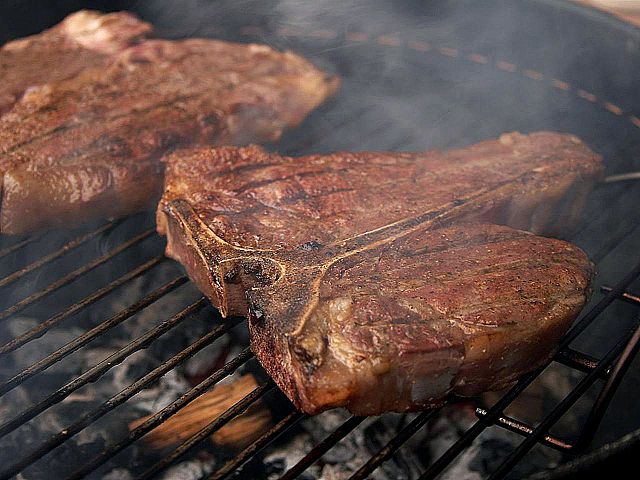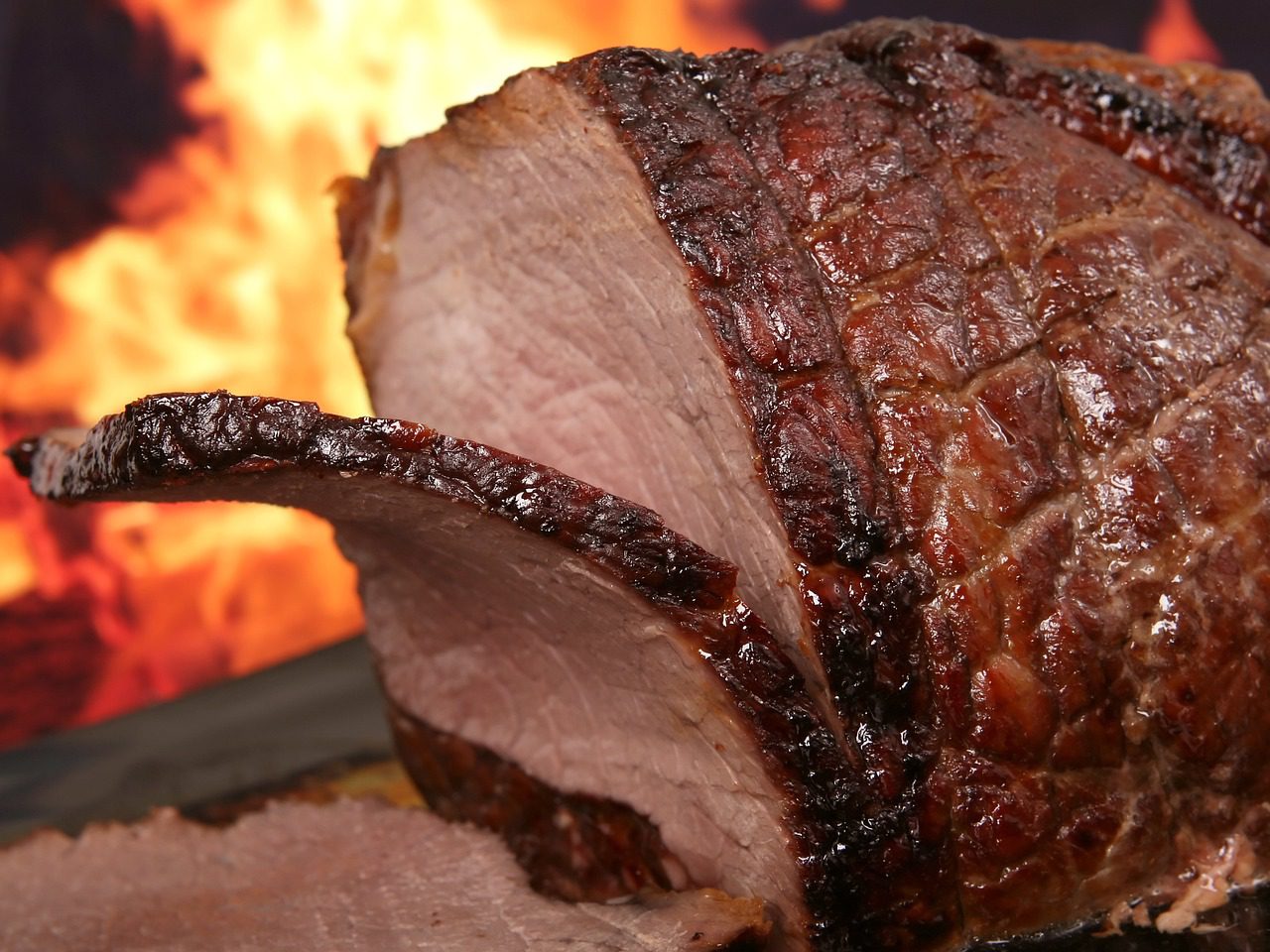Autumn is officially here, and if you’re anything like me, you’re a little sad that the smell of charcoal and mosquito spray is going away with the summer. I’m also always a little sad knowing that I won’t have the treat of my husband’s latest barbecued meal on my Dixie plate when dinner time rolls around in the winter months. Whether it is the hundreds of pounds of pulled pork he makes for our family’s annual pig roast in Michigan or a simple charred salmon with fresh corn on the back porch, the fish skin delicately charred and greasy as you flake it onto your fork, I will surely miss it.
Speaking of my significant other, he’s joining me on this blog post. A microbiologist by training and a scion of Texan cattle ranchers, my husband Eric Veggeberg prides himself on the ability to identify the types of meat used for either grilling and barbecuing, based on the fact that the temperatures needed and the methods that should be used vary strongly by protein type. Additionally, he’s going to help us break down the difference behind the two cooking methods in terms of the cooking temperatures that will make the meat both delicious and safe to eat.
He’s that guy in Whole Foods who will interrogate the poor butcher on the cut of their meats like they’re at a police station on Luke Cage (except instead of trying to learn the location of the latest Marvel universe criminal he’s chasing, Eric will be grilling the poor employee on how dry-aged that ribeye really is).
First, and perhaps most importantly for us as self-proclaimed connoisseurs of outdoor cooking, it’s critical to note that grilling and barbecuing are actually two different forms of food preparation that will depend on the chemical composition of the meat that you are serving (because not every tissue from every animal will be cooked the same). Saying that you are preparing to grill something and then going and barbecuing it instead will lead to some confusing, and potentially dangerous, meals.

A porterhouse steak on the grill
On that note, are you serving beef, pork, chicken, lamb, alligator, rattlesnake, or tofu this evening?*
Though they both take part over forms of open flame, barbecue and grilling differ in several ways. Grilling requires meat to cook in a fast, hot way, over a direct heat source, such as coals. The heat source is generally at 500-550 degrees Fahrenheit, possibly higher if need be. Chefs generally recommended this method if you want meat, like steak, that truly ‘shines’ on its own, without tons of sauce.
Since grilling uses such a high temperature (a very hot temperature compared to the temperature of the meat), it heats the meat a very steep gradient. That is, the outer portions of the meat heat up much more quickly than the inner portions, which is why you can get a crisp sear on your steak and still leave the middle pink and juicy. Meanwhile, barbecuing involves cooking meats over an indirect source of heat (such as a smoker) for a longer period of time at a lower temperature, starting at 225 degrees Fahrenheit or so. Since the temperature is lower, and the difference between the temperature of the heat source and the steak is smaller, the meat heats at a much shallower gradient – the whole piece of meat heats much more evenly. This gives the time in your pork shoulder or brisket to break down throughout without burning the edges.

Barbecued beef
Barbecuing uses cheaper portions of the meat from the animal and chars them in a way that makes the meat easy to eat. Save barbecuing for the animal pieces that contain more dense tissue. Cuts like this need to be broken down over a period of time, ranging from a little over an hour to a whole day (for my husband’s rib tips), over an open source of heat. Thicker muscular tissue, such as a shoulder of pork or a brisket of beef, needs long, slow cooking to break down. The same goes for connective tissue that might otherwise be too chewy or hard to eat on its own.
While this may sound a little gross, this allows the meat to obtain the smoky flavor we associate with this type of food, and allows the tenderness of the meat to come out. Who wants chewy pulled pork or ribs you have to gnaw on?
This chewiness also stems from the actual structure of the cell tissue that you are consuming. These ‘barbecuing’ cuts normally come from muscles that move a lot, such as the shoulder or rump. Active muscle from ungulates not only produces a thicker, juicier cut of meat, but because it also tends to harbor fewer parasites, doesn’t need as much heat to cook it.
Chickens have a propensity to host parasites that could make you really sick, such as the infamous salmonella bacteria, therefore, the USDA strongly advises that you barbecue the bird to make sure you don’t poison yourself with raw-centered chicken.
Pork is not much better than chicken, as it can also host multiple bacteria that can make humans incredibly sick, including the notorious tapeworm parasite known for making thousands across developing nations violently ill. But as long as you cook the meat at an internal temperature of 145 degrees Fahrenheit, the USDA says you’ll be okay.
“Whoa,” you say over your pulled pork sandwich and your buffalo wing dripping with Kansas City’s finest sauce, “but I’m eating barbecue!“
You’re right, to an extent: many times, cooks cover grilled meat in a sauce meant to serve as a dipping sauce to enhance the flavor of the meat and to make the meat look, smell, and taste barbecued. They generally do this to disguise bad flavors, whether they’re due to meat that has gone rancid or has been prepared in a less than adequate way. If you read the wonderful anthropological book on the subject of cooking meat, The Slow and the Slaw, you can learn more about how the animals traditionally used for barbecue and the styles in which they’re prepared reflect the American mid-South region, arguably where barbecue as we know it began.
But I warn you: don’t cross a Texan like Eric with a sauced-up piece of barbecued meat—putting sauce on barbecue in Texas is sacrilege.

An assortment of sausage and steak that’s perfect for grilling
Anyway, unlike chicken and pork, meats that have been previously treated and cured, such as sausage of any meat origin, are almost universally safe for human consumption due to how they’re prepared. These meats cross the line as meat products that can be either barbecued or grilled in order for us to safely eat.
Even though summer’s over, I hope you can use this information in the future. Happy eating!
*Due to tofu’s high water content and low cooking temperature on account of it being a plant product, I would strongly recommend grilling it, or, if you’re craving that charred flavor, putting it in a baking tray after dropping it in a basting liquid of your choice. I’ve never cooked a reptile, but due to the protein composition of the animal, Eric recommends treating it like poultry: make sure it is thoroughly cooked at a high temperature (500-550 degrees Fahrenheit) to make sure that all bacteria have been killed.
-
Kristen Vogt Veggeberg, Ph.D., is a science educator and content writer based in Chicago. Find her on Twitter @KrisVeeVee.
View all posts









